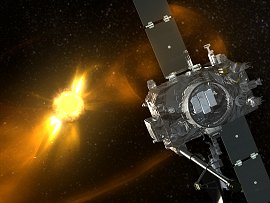STEREO Looking for Planet that Collided with Earth courtesy of Space Weather.com
NASA's twin STEREO probes are entering a mysterious region of space to look for remains of an ancient planet which once orbited the Sun not far from Earth. If they find anything, it could solve a major puzzle--the origin of the Moon.
"The name of the planet is Theia," says Mike Kaiser, STEREO project scientist at the Goddard Space Flight Center. "It's a hypothetical world. We've never actually seen it, but some researchers believe it existed 4.5 billion years ago—and that it collided with Earth to form the Moon."
The "Theia hypothesis" is a brainchild of Princeton theorists Edward Belbruno and Richard Gott. It starts with the popular Great Impact theory of the Moon's origin. Many astronomers hold that in the formative years of the solar system, a Mars-sized protoplanet crashed into Earth. Debris from the collision, a mixture of material from both bodies, spun out into Earth orbit and coalesced into the Moon. This scenario explains many aspects of lunar geology including the size of the Moon's core and the density and isotopic composition of moon rocks.
It's a good theory, but it leaves one awkward question unanswered: Where did the enormous protoplanet come from?
Sun-Earth Lagrange points are regions of space where the pull of the Sun and Earth combine to form a "gravitational well." The flotsam of space tends to gather there much as water gathers at the bottom of a well on Earth. 18th-century mathematician Josef Lagrange proved that there are five such wells in the Sun-Earth system: L1, L2, L3, L4 and L5 located as shown in the diagram to the lower right.
When the solar system was young, Lagrange points were populated mainly by planetesimals, the asteroid-sized building blocks of planets. Belbruno and Gott suggest that in one of the Lagrange points, L4 or L5, the planetesimals assembled themselves into Theia, nicknamed after the mythological Greek Titan who gave birth to the Moon goddess Selene.
"Their computer models show that Theia could have grown large enough to produce the Moon if it formed in the L4 or L5 regions, where the balance of forces allowed enough material to accumulate," says Kaiser. "Later, Theia would have been nudged out of L4 or L5 by the increasing gravity of other developing planets like Venus and sent on a collision course with Earth."
If this idea is correct, Theia itself is long gone, but some of the ancient planetesimals that failed to join Theia may still be lingering at L4 or L5.
"The STEREO probes are entering these regions of space now," says Kaiser. "This puts us in a good position to search for Theia's asteroid-sized leftovers."
Just call them "Theiasteroids."
Astronomers have looked for Theiasteroids before using telescopes on Earth, and found nothing, but their results only rule out kilometer-sized objects. By actually entering L4 and L5, STEREO will be able to hunt for much smaller bodies at relatively close range.
"The search actually began last month when both spacecraft rolled 180 degrees so that they could take a series of 2-hour exposures of the general L4/L5 areas. In the first sets of images, amateur astronomers found some known asteroids and new comet Itagaki was imaged just a couple of days after the announcement of its discovery. No Theiasteroids however."
Hunting for Theiasteroids is not STEREO's primary mission, he points out. "STEREO is a solar observatory. The two probes are flanking the sun on opposite sides to gain a 3D view of solar activity. We just happen to be passing through the L4 and L5 Lagrange points en route. This is purely bonus science."
"We might not see anything," he continues, "but if we discover lots of asteroids around L4 or L5, it could lead to a mission to analyze the composition of these asteroids in detail. If that mission discovers the asteroids have the same composition as the Earth and Moon, it will support Belbruno and Gott's version of the giant impact theory."
The search will continue for many months to come. Lagrange points are not infinitesimal points in space; they are broad regions 50 million kilometers wide. The STEREO probes are only in the outskirts now. Closest approach to the bottoms of the gravitational wells comes in Sept-Oct. 2009. "We have a lot of observing ahead of us," notes Kaiser.
|
 |
| Artistic conception of Stereo Probe |
|
|
|
What the Well-Dressed Ham is Wearing this Season....
Due to popular demand I have ordered a stock of baseball caps and polo shirts embroidered with the BARK logo. The hats are two tone, natural over a navy bill, with a six panel, structured twill dome. The polo shirts are a "silk -like" beige cotton. All of the apparel is high quality and made by Port Authority. I will be receiving a supply of all cotton, unstructured baseball caps and some 2XL polo shirts soon. Currently I have shirts in sizes medium, large and X-Large. The hats are $15 each and shirts are $20.
|
|